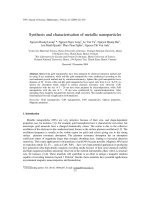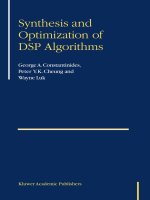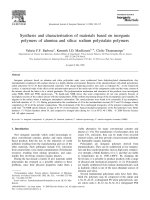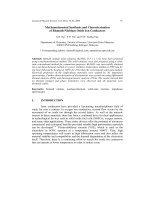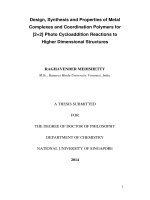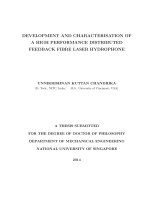Synthesis and characterisation of electrical conducting polymers co polymers based on omega functionalised 3 alkylthiophenes 4
Bạn đang xem bản rút gọn của tài liệu. Xem và tải ngay bản đầy đủ của tài liệu tại đây (874.53 KB, 52 trang )
Chapter 4
Graft copolymers of polythiophene and PMMA
131
1.
Introduction
:
As
was
discussed in the previous chapter, the properties of the graft copolymers
of PS and polythiophene is affected by
their
backbone
structure
.
T
he properties of
the graft copoly
mer
s can be changed by altering or replacing the polythiophene
and/or PS backbone structure. In this chapter, the different properties of the graft
copolymers with poly(methyl methacrylate) PMMA and polythiophene
backbones
will be explored. These graft copolymers essentially have structures
similar to PS and polythiophene graft copolymers
.
The main difference would be
the presence of the PMMA in place of
the
PS backbone.
Hence
any
property
differences
of the copolymers should be caused mainly by this change of
structure.
The idea of integrating PMMA and polythiophene into a copolymer system has
interested many. A direct approach was to form linkages between thiophene or its
derivatives and MMA to give block copolymers. This can be achieved by both
chemical
[1] and electrochemical methods [2]. The copolymers were reported to
be soluble and conducting although these properties depend on the amount of
thiophene moiety that could be integrated into the system. P
oly(3
-
alkylthiophene)
containing terminal acrylate or methacrylate functional group on the alkyl side
chain
s have been reported. Such material can be copolymerised by radiation,
either UV or electron beam, to produce highly cross-linked insoluble
graft
copolymers, which make these materials useful for photolithographic patterning
[3
-6]. Grafting of poly(methyl methacrylate) (PMMA) to polypyrrole and
132
polythiophene
via
an ester linkage has also been shown to give soluble graft
copolymers with moderate conductivity [7a-
d].
More r
ecent
ly
the syntheses of
PMMA
and polythiophene or polypyrrole copolymers linked through
ester
linkage
were reported [8a
-
b]
.
The
PMMA and polythiophene
graft
copolymers
prepared
in this
project
will
have PMMA and polythiophene backbones linked through alkyl chain linkages
.
These graft copolymers
was
made in a similar approach as described in the
previous chapter for PS and polythiophene copolymers. A novel monomer of
functionalised 3-alkylthiophene, which contain
ed
a terminal
,
-
unsaturated
ketone group,
wa
s synthesised. This monomer c
ould
be polymerised directly
thr
ough a two-step reaction.
It
may
also be copolymerised with MMA and
thiophene
in turn to give another graft copolymer. Similarly, this monomer can
be
copolymerised with MMA and 3-
alkylthiophene
s of different alkyl chain lengths
to afford another two graft copolymers. The details of the experiments
are
described below.
133
2.
Experiment:
2.1
Monomer s
ynthesis:
The synthesis of the novel monomer
5
is depicted in the following scheme:
HO CH
2
Triphenylphosphine
Bromine
Grignard Rxn
9
Br CH
2
9
S
CH
2
9
SeO
2
/tBHP
S
CH
2
8
OH
KMnO
4
Charcoal
S
CH
2
8
O
1 2 3
4
5
Scheme 4.1
Synthesis of monomer
5
St
arting material 1-
hydroxylundec
-
10
-
ene
(1
)
was brominated in excess bromine
and triphenylphosphine with high yield. The brominated product was then
coupled with 3-bromothiophene through Grignard reaction. As reported in
literature [9], this straightforward reaction gave high yield although a small
amount of 2, 3 vinyl isomer (11-b
romo
-
undec
-2-ene) was detected together with
compound
2
(see scheme above)
.
The oxidation step
using
selenium dioxide was less straightforward.
SeO
2
has
been known as an effective alkene oxidising agent that forms
,
-
unsaturated
alcohol and/or
,
-unsaturated carbonyl products [10]. The reagent is
particularly interesting to many organic chemists due to its regio- and stereo-
134
specific nature [11, 12]. These reports described that the reaction gave higher
yield when the double bond groups
we
re more substituted, as well as the use of
stoichiometric amounts of SeO
2
with excess t-butylhydroperoxide (tBHP) to
maintain the selenium in the reactive Se (IV) oxidation state.
Moderate
yields of
allylic alcohol c
ould
still be obtained from
the
less substituted alkenes. Another
report described a method of selective oxidation of primary allylic alcohols to
, -unsaturated aldehydes [13]. In th
at
experiment, an oxidsing reagent of
SeO
2
/tBHP/Si
O
2
was used instead of the traditional MnO
2
oxidising agent to
oxidise alcohol into aldehyde. It was hoped that applying the reagent mentioned
in Kalsi et al.’s paper [13] would directly oxidise 3-
(unde
-
10
-enyl)thiophene (3
)
to 11
-
thiophen
-3-
yl
-
undec
-2-
ena
l,
as shown below.
11-thiophen-3-yl-undec-2-enal
S
CH
2
8
O
S
CH
2
9
3
SeO
2
/tBHP/SiO
2
The main difficulty expected was that the mono substituted alkene has low
reactivity towards such oxidising agent. True enough, when the reaction was
carried out, a large portion of the starting material remained unperturbed. There
we
re no major products, although the expected aldehyde was detected
using
NMR. Other products
formed
include the
,
-unsaturated ketone. The reaction
was repeated a few times under different conditions. Although a higher
percentage of
the
mono substituted alkene c
ould
be oxidised, there w
ere
still no
major products. Hence this reaction route was abandoned for the more
‘traditional’ two
-
step oxidation method.
135
In the first step, the ratio of SeO
2
: tBHP: alkene used was
0.5:2:1.
A mixture of
oxidised products was formed as expected. The reaction mechanism suggests that
the terminal unsaturated allylic alcohol should be the major product, as illustrated
below:
Scheme 4.2
Possible mechanisms for the formation of
4
as the major product
The complex formed by S
eO
2
and tBHP kept the selenium centre at a higher
oxidation state of IV [11, 12], which ma
de
it prone to nucleophilic attack from the
alkene groups. There are two possible sites
of
attack, namely positions 1 and 2
H
H
H
C
(CH
2
)
7
-TH
H
H
Se
O
O
HO
O
t
Bu
H
H
H
C
(CH
2
)
7
-TH
H
Se
OH
O
HO
O
t
Bu
H
H
H
C
(CH
2
)
7
-TH
H
Se
O
O
HO
O
t
Bu
H
H
H
C
(CH
2
)
7
-TH
H
Se
O
HO
HO
O
t
Bu
O
H
+
H
H
C
(CH
2
)
7
-TH
H
OH
1
2
3
4
136
(see scheme above). Attack
at
position 1 w
ould
form a six-membered ring
transition state, which would result in a stabilised allylseleninic ester transition
state with a di-substituted double bond. Subsequent C-Se bond rotation and
sigmatropic rearrangement
would
give an ester that was readily hydrolysed by
tBHP to form the alcohol. At the same time, the oxidising agent would be
regenerated. This is a thermodynamically favoured reaction route.
The alternative attack
is at
position 2. At the intermediate stage
,
the adjacent alkyl
group may help to stabilise the electron poor carbon 2 compared to the attack
at
position 1, as shown below:
H
H
H
C
(CH
2
)
7
-TH
H
H
Se
O
O
OH
O
t
Bu
1
2
3
H
H
H
C
(CH
2
)
7
-TH
H
H
SeHO
O
OH
O
t
Bu
1
2
3
137
This
might
lower the activation energy for the reaction to take place. However,
such an attack
would
also lead to a carbocation transition state that is highly
unstable.
Continued rearrangement of this intermediate
would
lead to an allylic alcohol
with a terminal alcohol that could be one of the minor products. Further oxidation
of the alcohol
would
result in an aldehyde. As mentioned earlier, some
,
-
unsatu
rated
aldehyd
ic
product was detected when 3 was oxidised with
SeO
2
/tBHP/SiO
2
. The abovementioned reaction intermediate
might
have
contributed t
o the formation of that product.
Th
e oxidation reaction of 3 using SeO
2
and tBHP in 0.5 to 2 ratio was usually
allowed to react overnight. About 50% of the starting material was recovered in
most cases. Prolonged reaction time did not improve the yield much. Moreover,
more side products were produced thus creating complications during
purification.
In the second oxidation step, a more conventional oxidising agent was prepared
by adsorbing KMnO
4
on charcoal, as described in literature [14]. The reaction
gave the desired product in
moderate
yield
(~35%)
.
138
2.2
Copolymers s
ynthes
e
s:
The first step
wa
s carried out by p
olymerising
5
using AIBN as initiator to give
6
.
Polymer
6
wa
s then oxidatively polymerised with FeCl
3
to yield graft copolymer
7
, as shown below:
S
CH
2
8
O
S
CH
2
8
O
n
S
CH
2
8
O
n
m
AIBN
FeCl
3
5
6
7
Scheme 4.3
Synthes
i
s of graft copolymer
7 from monomer 5
The precursor polymer 6 formed after the first step was a sticky solid that could
be dissolved in solvents such as CHCl
3
and CCl
4
. After the second polymerisation
step, the resultant polymer was found to be insoluble. It seemed to ‘swell’ in the
solvents, a sign
of
cross
-
linkage
in its structure
.
In order to obtain a more processable copolymer, the monomer was first
copolymerised with MMA in 1:9 ratio using AIBN as initiator. The precursor
copolymer (8) obtained was dissolved in CCl
4
and further copolymerised with
thiophene
in a 1:9 ratio to give graft copolymer 9. It was also
copolymerised
with
3-
butylthiophene
in a 1:9 ratio
to yield graft copolymer
10
. Similar to the case for
PS graft polythiophene as discussed previously, the conductivity and solubility of
the graft copolymer containing 3-
butylthiop
hene improved drastically. The
precursor copolymer (8
)
was also copolymerised with 3-dodecylthiophene in 1:9
ratio using the same method to produce graft copolymer
11
.
The effects of chain
139
length on the properties of the graft copolymers can be investigate
d by comparing
the properties of copolymers
10
and
11
.
S
CH
2
8
O
S
CH
2
8
O
CH
2
CH
3
CH
2
O OMe
n
AIBN
MMA
S
CH
2
8
O
CH
2
CH
3
CH
2
O OMe
n
S
m
FeCl
3
S
5
8
9
Scheme 4.4
Synthes
i
s of graft copolymer
9
S
CH
2
8
O
S
CH
2
8
O
CH
2
CH
3
CH
2
O OMe
n
AIBN
MMA
S
CH
2
8
O
CH
2
CH
3
CH
2
O OMe
n
S
m
(H
2
C)H
3
C
x
FeCl
3
3-alkyl-
thiophene
5 8 10 (x=4), 11 (x=10)
Scheme 4.5
Syntheses of graft copolymers
10
and
11
140
3.
Result and Discussion:
3.1
Monomer
s
ynthes
i
s and
characterisation
1-
bromoundec
-
10
-ene were characterised by
1
H NMR (NMR not shown here).
The appearance of a quartet at 3.39 ppm evidenced the bromination of the starting
material. The Hs on the double bond was intact too. However, an impurity was
detected at 5.48 ppm, which could not be removed despite repeated column
chromatography and distillation. This impur
ity
could
most likely
be
due to
isomerisation of the double bond from terminal to 2, 3 positions on the alkyl
chain.
The Grignard reaction product, 3-
(unde
-
10
-enyl)thiophene, was characterised
usi
ng FT-
IR,
1
H NMR and elemental analysis. On the NMR spectrum (see Fig
4.
1), there were no peaks observed at 3.30 ppm, which was an indication that Br
from
the
starting material was not present in th
is
compound. Instead, a triplet
appeared at 2.63 ppm owing to the –
CH
2
group next to a thiophene ring. The
multiplets at around 6.93 and 7.24 ppm confirmed the presence of thiophene
groups. All are evidence that the substitution of Br by thiophene have taken place.
The isomerisation of the double bond is verified
by the weak band at 5.48 ppm.
141
Fig. 4.1
1
H NMR of 3
-
(unde
-
10
-
enyl)thiophene
(3)
The
1
H NMR of 11
-
thiophen
-3-
yl
-
undec
-1-
en
-3-ol is shown below (Fig. 4.2). The
peak at 4.1 ppm, which accounted for one hydrogen atom on the molecule,
accounts for the –CH next to a hydroxyl group. The high chemical shift was a
result of the deshielding effect inserted by the double bond neighbouring it.
Similarly, the presence of allylic alcohol also affected the chemical shift of alkene
Hs. The deshielded cis and trans
Hs gave rise to a doublet, which was further split
by the hydrogen on carbon 2 of the terminal double bond to give a doublet of
doublets at 5.2 ppm. The H at the C2 position had a more complicated chemical
environment that produced multiplets at 5.83 ppm. The presence of thiophene was
confirmed by the triplet at ~2.6 ppm and the multiplets at 6.9 and 7.26 ppm in the
S
CH
2
9
3
142
aromatic region. The spectrum below proved that the oxidation reaction did
produce 11
-
thiophen
-3-
yl
-
undec
-1-
en
-3-
ol as a major product.
Fig
. 4.2
1
H NMR of 11
-
thiophen
-3-
yl
-
undec
-1-
en
-3-
ol (
4)
However, the weak bands between 5.2 ppm and 5.83 ppm indicated the presence
of
an
impurity that was most likely the oxidised product of the isomer of 3-
(unde
-
10
-enyl)thiophene. Repeated column chromatography could not remove this
impurity. Distillation was not carried out for fear of losing the major product to
heat
-induced polymerisation. The amount of impurity was considered negligible
(less than 4 mol %) in all the experiments carried out. Hence, t
he
following step
was allowed to proceed with the impurity present.
The
13
C NMR spectrum (Fig. 4.3
)
also confirmed the presence of
the
allylic
alcohol. The ethylene carbons caused peaks at 143 and 141 ppm, whereas the
deshielded hydroxyl group connected to C gave rise to the peak at 73.2 ppm. The
peak at 37 ppm is ascribable to the alkyl –
CH
2
group next to the hydroxyl group.
S
CH
2
8
OH
4
1
2
143
The 3-substituted thiophene ring was evidenced by peaks at 128.2, 124.9, 119.7
and 114.5 ppm, together with a peak at 30.5
ppm
that was a result of
the
–
CH
2
group
beside the ring.
Fig. 4.3
13
C NMR spectrum of 11
-
thiophen
-3-
yl
-
undec
-1-
en
-3-
ol (
4)
The spectroscopic evidences conclusively proved the formation of the allylic
alcohol through oxidation by SeO
2
/tBHP reagent. Despite the moderate yield,
which can be attributed to the difficulty of oxidising a mono-substituted alkene,
the reaction
was considered
feasible and provided enough products for subsequent
oxidation.
S
CH
2
8
OH
4
144
The
1
H spectrum of 11
-
thiophen
-3-
yl
-
undec
-1-
en
-3-
one is depicted bel
ow.
Fig. 4.4
1
H NMR spectrum of 11
-
thiophen
-3-
yl
-
undec
-1-
en
-3-
one (
5)
The ethylene hydrogen atoms that were deshielded by
the
carbonyl group gave
rise to complicated multiplets at ~5.8 ppm and ~6.3 ppm. Compared to the
starting material, the shift of these Hs downfield had to be due to the presence of
the carbonyl group. Since the carbonyl carbon has no H attached to it, the H
atoms
on the double bond
ed
carbons
self coupled. One can expect the H that is cis
to the carbonyl double bond to have a high chemical shift. The strong geminal
coupling with the trans H may even split the doublet so strongly that it result
ed
in
the peak at ~5.8 ppm. The integration of the six peaks in this region accounts for
the three alkene Hs. Coincidentally, the –
CH
2
group next to the carbonyl group
produced peaks at the same chemical shift as the methylene group adjacent to the
thiophene group. The integration of these muliplets at ~2.6 ppm indicated
the
S
CH
2
8
O
5
145
presence of two methylene groups. The thiophene ring was not affected and
showed coupling at ~6.9 and 7.2 ppm.
On the
13
C NMR spectrum,
the
peaks at 200.1, 143.1, 136.6 ppm proved
that
the
major product of the oxidation
reaction
did contain
primary
,
unsaturated
ketone groups. Other peaks were similar to those observed on the spectrum of the
starting material, except the peak at 39.6 ppm, which in fact represents two carbon
atoms, one next to the carbonyl and the other adjacent to the thiophene ring.
Fig. 4.5
13
C NMR spectrum of 11
-
thiophen
-3-
yl
-
undec
-1-
en
-3-
one (
5)
The
major side product of the reaction was identified by NMR (Fig 4.6
)
to be 11-
thiophen
-3-
yl
-
undec
-3-
en
-2-one. The alkene Hs on this compound w
ere
even
more deshielded compared to the major product and caused multiplets at ~6.8
ppm and 6.1 ppm. Another feature that distinguished this compound from the
major compound was the triplets at ~2.61 ppm and ~2.51 ppm, attributable to –
CH
2
groups next to the thiophene ring and the carbonyl group respectively.
As
S
CH
2
8
O
5
146
was
mentioned earlier, compound 4 was used with traces of an isomer. The
oxidation of this isomer most likely produced the side product, 11-
thiophen
-3-
yl
-
undec
-3-
en
-2-
one.
Although the impurity level in the starting material
4
was low,
substantial amounts of this side product was able to be accumulated througho
ut
the
many
oxidation reactions carried out
.
Nevertheless,
since
this
by
-
product
can
be separated in pure form from the major product
it
sh
ould not interfere with the
polymerisation process.
Fig. 4.6
1
H NMR spectrum of 11
-
thiophen
-3-
yl
-
undec
-3-
en
-2-
one
S
CH
2
7
O
147
3.2
Copolymers c
haracterisation
3.2.1
Physical properties
Graft copolymer 7 was an orange powder that was very slightly soluble in
chloroform. Copolymer 9 was a dark reddish powder that was partially soluble in
CHCl
3
. Copolymer
10
was also dark red and soxhlet extraction of the copolymer
with chloroform was able to dissolve ~80% of the polymer.
Cop
olymer
11
was a
slightly sticky black solid
with
solubility
properties
comparable to that of
copolymer
10
.
148
3.2.2
NMR
Two
-step polymerisation of the monomer
5
(see scheme 4.1) did not produce a
co
-polymer that was soluble. Hence no NMR
analysis
can be carried out for 7
.
The copolymerisation of
the
monomer with MMA and thiophene/3-
alkylthiophenes, on the other hand, generated largely soluble co-polymers. A
typical spectrum of one of these polymers, the graft copolymer of monomer,
MMA, and 3
-
butylthiophene (
10
) is shown below:
Fig. 4.7
1
H NMR spectrum of copolymer
10
The broad peak at 3.6 ppm was caused by the methyl ester group is typical for
PMMA. The peaks at 2.85 ppm and 2.58 ppm were due to –
CH
2
groups next to
the thiophene backbone connected in HT and HH fashion, as discussed in the
previous chapter. On the spectrum of the precursor copolymer 6, this same group
produced a triplet at ~2.6 ppm. The weak peak at ~2
.2
ppm was a result of
S
CH
2
8
O
CH
2
CH
3
CH
2
O OMe
n
S
m
(H
2
C)H
3
C
4
1
0
149
hydrogen resonance of the
–
CH next to the carbonyl group, which originated from
the monomer. This peak shifted more up field since the deshielding effect of the
double bond is absent. The existence of this peak proved that the monomer units
were integrated into the polymer backbone. The methylene group
found
on the
pend
ant chain next to the carbonyl group should have hydrogen resonance at ~2.
5
ppm. This peak could have overlapped with the peak caused by the –
CH
2
group
next to the thiophene ring. The broad band at 7.0 ppm was the result of the only
aromatic H left on the thiophene backbone.
150
3.2.3
FT-
IR
Infrared
spectra provided important insight into the structure of
the
graft
copolymers. This method is especially important for chara
cterising
copolymer
7
,
the only copolymer where the NMR spectrum could not be acquired due to its
poor solubility
. The diagram
that follows illustrates the IR spectra of
copolymer
7
(direct two step polymerisation of monomer 5)
,
copolymer
9 (graft copolymer of
monomer
5
, MMA and thiophene)
,
copolymer
10
(graft copolymer of monomer
5
,
MMA and 3-
butylthiophene)
and
copolymer
11
(graft copolymer of monomer 5
,
MMA and 3
-
dodecylthiophene)
(see Fig 4.
8)
.
The spectra of the four copolymers were quite similar due to the similarities in
their structures. The bands between 3100-3000 cm
-1
wer
e due to thiophene
aromatic C-H stretch present in all four polymers. The bands at around 2922 cm
-1
wa
s a result of asymmetric
-
CH
2
stretch and the band at 2849 cm
-1
wa
s ascrib
ed
to
symmetric
-
CH
2
stretch. These two bands were relatively weaker on
the
spectrum
of copolymer
9
, due to the lack of alkyl chains in this polymer.
The spectrum of
copolymer
7 can be distinguished from the spectra of the other
three copolymers
because of
the peak at 1709 cm
-1
. This band was caused by C=O
stretch of ketone groups, which were abundant in
copolymer
7. On the other three
copolymers, the C=O stretch of the ester groups from MMA gave rise to a band at
~1728 cm
-1
. The large amounts of such ester groups in
copolymers
9
,
10
and
11
151
would most likely have overlapped with the weak band at 1709 cm
-1
caused by
the presence of a small amount of ketone groups that originated from monomer 5
.
Fig. 4.8
Overlaid IR spectra of copolymers 7
,
9
,
10 and 11
Thiophene aromatic ring C-C stretching bands were evident on the spectra of all
copolymers at around ~1456 and ~1370 cm
-1
. The lack of ester groups in
copolymer
7 was once again noticeable due to the absence of the bands at 1238-
152
1146 cm
-1
attributed to esters’ C-O stretch. These peaks were evident on the IR
spectra of
copolymers
9
,
10
and
11
.
The spectra of
copolymers
7
,
10
and
11
share
d
a common medium peak at around
825 cm
-1
,
which
was
found as
a
weak peak on
copolymer
9
. On the other hand,
the
spectrum
of copolymer 9
had a medium peak at 785 cm
-1
that was not detected on
the other spectra. The band at 825 cm
-1
was caused by the C-H out-
of
-
plane
bending of 2,
3,
5-trisubstituted ring [15] of the polymerised 3-
alkylthiophene
rings, as discussed in the previous chapter. These tri-substituted polythiophene
rings were abundant in all the copolymers except copolymer 9, which
consist
ed
mainly of di-substituted polythiophene rings. Hence, in its spectrum, aromatic C-
H out of plane bend showed up as 785 cm
-1
and there was only a weak peak
appearing in this region that was caused by the little amounts of tri-
substituted
polythiophene rings originating from its precursor copolymer
8.
The IR spectra of the four
graft
copolymers confirmed the presence of the major
func
tional groups in their structures. One can also gain insight to the differences
in structure between these copolymers, however subtle they are.
153
3.2.4
Elemental Analys
is
Based on the elemental analysis results, the empirical formulae of the
graft
copolym
ers
wer
e calculated and compared with the
theoretical
formula calculated
based on the feed ratio of the monomer. The results are shown in the table below.
Also listed is the percentage molecular weight of the thiophene unit in the graft
copolymers estimated as follows:
Percentage molecular weight of the thiophene unit
=
n
Mw of thiophene
Mw of graft copolymer
100%
Where n = no. of S element in the copolymer formula. This gives an indication of
the relative amount of polythiophene
content
in the
g
rafted copolymer.
Table
4.1
Elemental analys
i
s results of the graft copolymers
Co
-
polymers
Experimental
formula
a, b
Theoretical
formula
Experimental
the
percentage
molecular weight
of the thiophene
unit
(%)
c
Theoretical
the
percentage
molecular weight
of the thiophene
unit
(%)
7
C
15.5
H
21.8
O
1.4
S C
15
H
20
OS
32.
1
33.9
9
C
92
H
126
O
16
S
10
C
96
H
111
O
19
S
10
46.
6
44.
6
10
C
112
H
152
O
17
S
10
C
132
H
182
O
19
S
10
40.3
35.2
11
C
202
H
305
O
25
S
10
C
204
H
344
O
19
S
10
24.
4
24.8
a.
The formulae were calculated using the amount of S as standard (meaning the
content of other elements were normalised
using
the sulphur content)
b.
The amount of oxygen was obtained by subtracting 1 with the sum of the content of
other elements
c.
The feed ratio for
copolymers
9, 10
and
11 were monomer 5 : MMA : thiophene(
for
9)
/3
-
alkylthiophen
(for
10 and 11
)
= 1:
9:
9
In terms of
experimental
formula,
copolymer
7
(direct two step polymerisation of
monomer
5)
ha
s
the closest agreement with the
theoretical
formula. Copolymer
11
154
(graft copolymer of monomer 5, MMA and 3-
dodec
ylthiophene)
has the closest
agreement with the expected percentage molecular weight of the thiophene unit
.
The other two graft copolymers’ empirical formula
e
showed discrepancy from the
formula calculated based on their feed ratio.
The close agreement between the empirical and expected formula of
copolymer
7
can be attributed to the fact that this graft copolymer was formed exclusively
using a single monomer
5.
The differences between theoretical and experimental
formula
e for copolymers 9, 10
and
11
we
re
most likely the result of a complicated
polymerisation process that involved three monomers.
